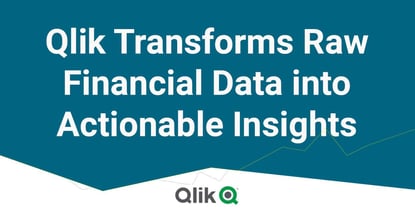
Our experts and industry insiders blog the latest news, studies and current events from inside the credit card industry. Our articles follow strict editorial guidelines.
In a Nutshell: Modern banking, insurance, securities, and investment firms have copious amounts of data at their disposal, but they can’t act on it if they don’t know what it means or if insights don’t arrive in time. Qlik offers a full-stack cloud platform that can gather multiple transactional and operational data streams and instantly transform them into information that decision-makers can use confidently. Financial enterprises seeking an edge in a competitive marketplace deploy Qlik business intelligence solutions to transform raw data into information with decision-making value.
Data availability in modern financial services is a source of competitive opportunity and stress. There’s never been a time when firms had as much data for integration and analytics as they do today. But firms saddled with expensive-to-replace yet perfectly functional legacy infrastructure need solutions to cope with that reality while taking advantage of the insights modern data analytics can produce.
Qlik bridges the legacy past to the digital present and future for enterprise-level firms in many industries, including financial services. Qlik’s end-to-end cloud solution for producing value from data helps enterprises worldwide achieve greater agility and decision-making precision to drive innovation and gain a competitive edge.

The company boasts a 30-year history of helping customers better understand their business trajectories. But it has never rested on its laurels. CK Tan, Senior Director of Global Solutions and Value Engineering at Qlik, said recent corporate acquisitions have rounded out Qlik’s cloud offering to make it the world’s largest independent data integration analytics company.
“We started in Sweden with the straightforward purpose of helping customers answer the business question through data discovery,” Tan said. “Now Qlik is at the epicenter of transforming raw data into a form ready for analytics and decision-making.”
Qlik’s acquisition of Attunity brought Change Data Capture technology to help firms achieve data integrity and consistency across systems and deployments. Acquiring Talend, already a leader in data integration, management, and governance, brought full-stack capabilities to Qlik.
“This is the pace of innovation,” Tan said. “As financial data continues to move from on-premise to the cloud, Qlik is there to generate new use cases around the idea that data insights should be more real-time.”
Replace Data Reporting with Data Discovery
The new Qlik Cloud closes the gaps between data, insights, and action through Active Intelligence. Qlik’s data integration solutions help bridge gaps between legacy infrastructure and analytics platforms. Qlik Sense®, its analytics platform, delivers insights decision-makers can count on.
Together, Qlik’s real-time, AI-driven, collaborative, and actionable data and analytics help financial firms make every business moment count. Qlik helps them achieve this by generating up-to-date, real-time information to respond to events as they evolve in a way that inspires confidence.

Tan said there are implications and benefits spanning the enterprise office, from back-end functions to the middle and customer-facing front offices. However, many Qlik customers start their digital transformation journey by replacing legacy systems on the back end.
“Banks are taking a fresh look at legacy business intelligence platforms,” Tan said. “Yes, they’re great for data reporting, but when it comes to data discovery, particularly back-office functions, decision-makers want to do more with the data and get away from what is sometimes called Excel hell.”
The idea is to quickly put data in the hands of the analysts who need it. These days, nobody is in a position to click and wait 10 or 20 seconds for a response. That’s where Qlik’s associative engine kicks in: many financial services organizations don’t see Qlik as a dashboard for reporting but as a business application for performing work.
Insurance firms use the insights to bolster underwriting. Bank Treasuries use Qlik for managing their cash positions. Investment funds in Singapore, where Tan is based, use the platform to analyze the profitability of their portfolio.
On the front office, Qlik shines as a tool for leading banks like HSBC and CaixaBank to help branch network employees review performance metrics and gain insight in customer needs.
“To sum up, we help the back office handle the day-to-day operations of the organization, the middle office with risk management and supporting frontend staff, and the front office around improving customer engagement with real-time insights,” Tan said.
Deliver Information to Any Analytics Environment
Qlik has solutions to fit most enterprise use cases. Many of the leading automotive firms in Germany and Japan turn to Qlik, for example, and in the US and EU, life sciences firms are prominent customers.
Key to Qlik’s versatility is its ability to plug into their critical business applications like SAP and various legacy mainframes, including those in the financial services use case. And its AI-powered innovations in data and analytics empower a range of industries to make actionable data available in enterprise relationship management, systems applications, and product software suites.
“A lot more of the data is now coming from the Internet of Things (IoT),” Tan said. “We see some of the top automotive companies in Germany starting to use IoT to do real-time predictive maintenance to improve their production lines.”

Those capabilities may seem peripheral, but they’re crucial to how Qlik works for financial enterprises as a digital data decoupler. When organizations, including financial services providers, with decades of history contemplate discarding the complex legacy infrastructure underpinning operations, many find it doesn’t make mathematical sense to do so. But then they lose out on speed and innovation when their competitors find rationales for making those investments.
Qlik helps the math work better and places enterprise banking firms — traditionally the most reticent innovators in today’s financial marketplace — on a level playing field with ostensibly more agile competitors.
“Some legacy banks seeking to release new products are not as quick as their competitors who have invested in digital transformation because they can’t decouple their data from their legacy systems — they can’t change the rules quick enough to develop a new product and services,” Tan said. “This is where Qlik technology like Change Data Capture, which can replicate data directly from a core banking or ERP system into a data warehouse or data lake, starts to drive innovation.”
Qlik: Data Integration as a Service Fosters Innovation
Tan said that’s because data does not only feed into reports and dashboards. Decoupling presents a growth opportunity as companies invest more energy into machine learning and generative AI capabilities to train enterprise data.
Beyond that, regulations such as the EU’s General Data Protection Rule make Qlik vital as a security and compliance mechanism across markets and regulatory jurisdictions.
“That leads to Qlik being a very hot brand when it comes to digital transformation,” Tan said. “In other words, we’re not done with digital transformation yet.”
Compliance is always top of mind in financial firms. Qlik expertly manages data lineage, tracing the data source and understanding the impact of any changes to make analyzing and investigating the data pipeline seamless.
Qlik’s acquisition of Talend brought those capabilities to the platform. The Talend acquisition also enabled Qlik to attach bridges into source and downstream business intelligence systems for robust analytics. The final data destination could be the Qlik analytics platform, but plugging the data into a competitor works, too.
Meanwhile, Qlik performs robust customer satisfaction due diligence to drive loyalty and spark innovation. As generative AI supplants blockchain and the metaverse as zeitgeist indicators in financial services and beyond, Qlik stays abreast of trends to anticipate where the new technology may have an impact.
No one yet knows where AI will take financial services in terms of understanding data and automating decision-making around it. But Qlik’s extensive industry footprint puts it at the forefront of AI innovation as it has with data integration and analytics.
“That’s why we have the highest customer renewal rate in the industry,” Tan said. “There’s a reason our customers continue to invest in themselves and in us to get trained in our software: so we can help them be successful.”



![21 Startling Credit Card Data Breach Statistics ([current_year]) 21 Startling Credit Card Data Breach Statistics ([current_year])](https://www.cardrates.com/images/uploads/2023/10/Credit-Card-Data-Breach-Statistics.jpg?width=158&height=120&fit=crop)
![7 Business Credit Cards With & Without Personal Guarantee ([updated_month_year]) 7 Business Credit Cards With & Without Personal Guarantee ([updated_month_year])](https://www.cardrates.com/images/uploads/2019/05/cover-5--1.jpg?width=158&height=120&fit=crop)
![7 Best Cash Back Credit Cards for Business ([updated_month_year]) 7 Best Cash Back Credit Cards for Business ([updated_month_year])](https://www.cardrates.com/images/uploads/2020/12/shutterstock_289823318.jpg?width=158&height=120&fit=crop)
![8 Business Credit Card Sign-Up Bonuses ($200 to $1250) – [updated_month_year] 8 Business Credit Card Sign-Up Bonuses ($200 to $1250) – [updated_month_year]](https://www.cardrates.com/images/uploads/2021/03/Business-Credit-Card-Sign-Up-Bonuses.jpg?width=158&height=120&fit=crop)

![9 High-Limit Business Credit Cards ([updated_month_year]) 9 High-Limit Business Credit Cards ([updated_month_year])](https://www.cardrates.com/images/uploads/2023/06/High-Limit-Business-Credit-Cards.png?width=158&height=120&fit=crop)
![8 Best 0% APR Business Credit Cards ([updated_month_year]) 8 Best 0% APR Business Credit Cards ([updated_month_year])](https://www.cardrates.com/images/uploads/2023/09/Best-0-APR-Business-Credit-Cards.jpg?width=158&height=120&fit=crop)